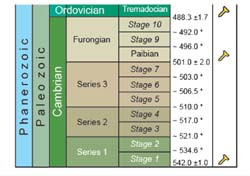

The Cambrian Period (543-490 million years ago) marks an important point in the history of life on Earth; it is the time when most of the major groups of animals first appear in the fossil record. A research team headed by Prof. PENG Shanchi from the CAS Nanjing Institute of Geology & Paleontology recently made a novel contribution to the Cambrian stratigraphy. Their scheme of subdividing the Cambrian System into four series and ten stages has been recently adopted by 2005 edition of the International Stratigraphic Chart, a popular corpus of the International Commission of Stratigraphy (ICS), putting an end to the traditional approach of three series.
Much paleontological work is concerned with stratum arrangements, which are important for understanding the evolution of life on Earth. Scientists use chronostratigraphic units (Erathem, System, Series, Stage) as correlative factors among rock sequences of different continents. They have set up a global coordinate chronostratigraphic/geochronologic chart, the International Stratigraphic Chart, to provide a time frame for the study of geological history and process of bio-evolution.
Until recently, the traditional subdivision of the Cambrian System into lower, middle and upper series had been used for about 170 years. The new scheme was first proposed by Prof. Peng at IX Conference of the Cambrian Stage Working Group held in Taebaek, South Korea in September 2004, and was published at the beginning of 2005. The proposal received overwhelming support from Voting Members of the International Subcommission of Cambrian Stratigraphy (ISCS). The changes in the new Chart signify that ICS has endorsed the vote of ISCS.
The achievement is hailed as a new breakthrough by the team. In 2000, the team suggested a subdivision scheme on South China's chronostratigraphy, consisting four series and nine stages and by now, the new scheme has been universally accepted and used by scholars all over the world. Not long ago, it was adopted by A Geological Time Scale 2004, the authoritative work on global stratigraphy as the sole comparative Chinese standard for international correlation, replacing the traditional North China Framework. In 2003, the team's scientists succeeded in establishing a new Global Standard-stratotype Section & Point (GSSP), or popularly known as the "golden spike," in northwestern Hunan Province as the first intra-Cambrian "golden spike." In addition, they added a Furongian Series and a Peibian Stage to the Cambrian System, two of global chronostratigraphic units named after Chinese geographical names in Hunan Province. The latest acceptance of the four-fold scheme for the global Cambrian System is another important innovation result achieved by the research team.






